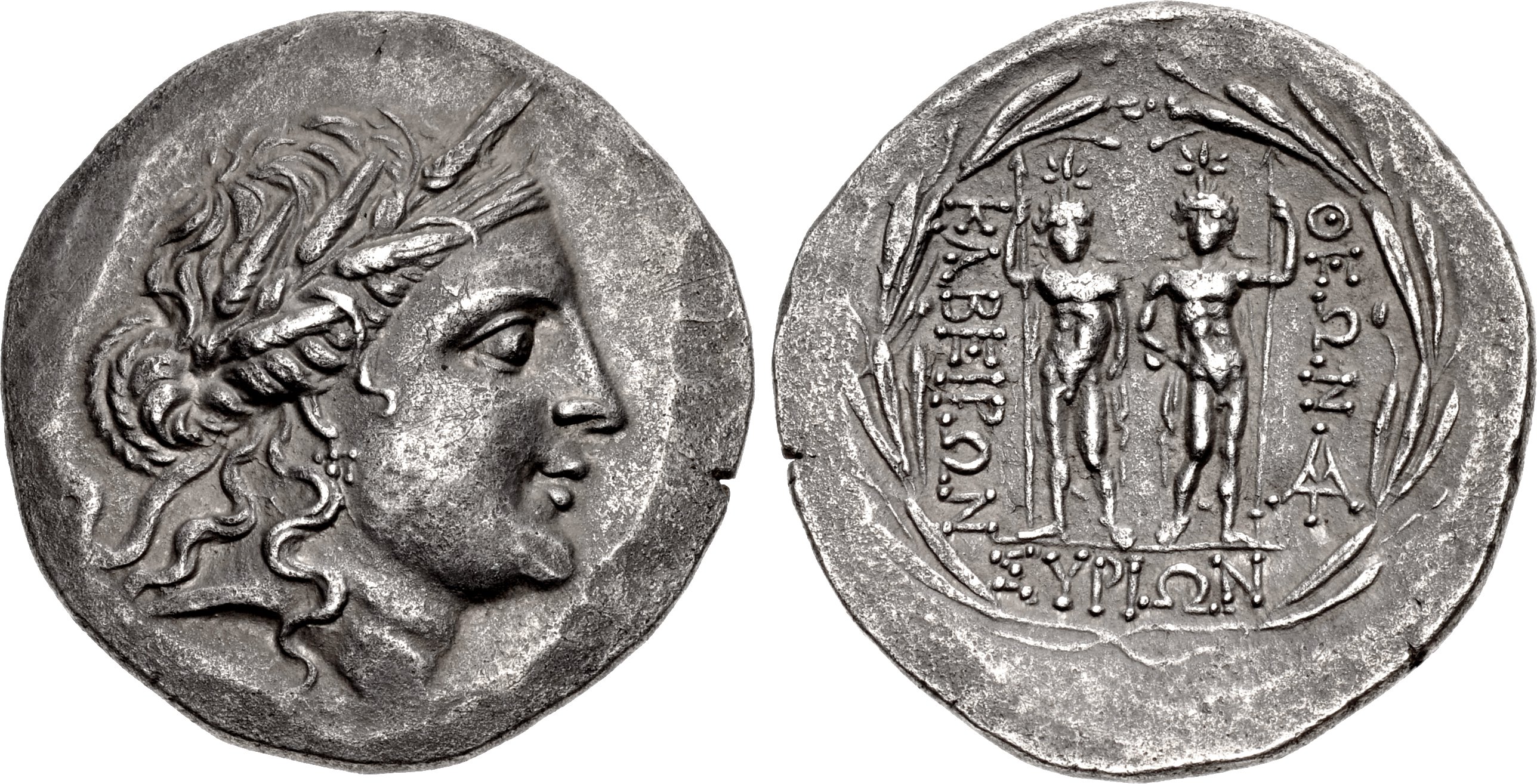Pergamum (Attalus II), silver, tetradrachms (Demeter/Cabiri) (145-140 BCE)
From SILVER
145 BCE - 140 BCE Silver 10,797 kg
Description
| ObverseInscription or printing placed on the obverse.: | Head of Demeter right, wearing wreath of grain ears and triple-pendant earring |
| ReverseInscription or printing placed on the reverse.: | ΘΕΩΝ ΚΑΒΕΙΡΩΝ ΣΥΡΙΩΝ (Greek).Two Kabeiroi, nude but for cloak tied at their necks, standing facing, each wearing laurel wreath and holding staff in outer hand, monogram to lower right, all within wreath |
Mint and issuing power
| MintIdentifies the place of manufacture or issue of a numismatic object.: | Pergamum | Ancient regionAncient region.: | Mysia | Modern countryModern country: Turkey | AuthorityIdentifies the issuing power. The authority can be "pretended" when the name or the portrait of X is on the coin but he/she was not the issuing power. It can also be "uncertain" when there is no mention of X on the coin but he/she was the issuing power according to the historical sources: | Attalid Kingdom, Attalus II (220-138 BCE) |
Chronology
| FromIdentifies the initial date in a range assigned in a numismatic context. | 145 BCE | toIdentifies the final date in a range assigned in a numismatic context.. | 140 BCE | PeriodTime period of the numismatic object.: Hellenistic 323-30 BC |
Physical description
| MetalThe physical material (usually metal) from which an object is made.: | Silver |
Median weightMedian of the weights of numismatic objects (in grams). in grams | 16.60 | DenominationTerm indicating the value of a numismatic object. Examples: tetradrachm, chalkous, denarius.: | tetradrachm |
StandardStandard.: | Attic |
Image

H192 Syros.jpg [1]
References
| Die study referencePublication of the study: | Nicolet-Pierre - Amandry 19921Nicolet-Pierre - Amandry 1992, Meadows 20132Meadows 2013, p. 184-191 | ||
| Coin series referenceReference to coin series study: | Sear I3Sear I, n° 3151, RQEMH4RQEMH, n° 192, HGC 65HGC 6, n° 709 | ||
| Coin series web referenceCoin series web references: | |||
Obverse dies distribution
Reverse dies distribution
no distribution is available
Quantification
| Number of obversesNumber of obverse dies. ᵖ (o) | 12 | Number of singletons (o1)The number of singleton coins. ᵖ | 8 |
| Number of reverse diesNumber of reverse dies. (r) | 16 | Number of coinsNumber of coins. (n) | 17 |
| Coins per obverse dieNumber of coins per obverse die. (n/o) | 1.42 | Coins per reverse dieNumber of coins per reverse die. (n/r) | 1.06 |
| Reverse per obverse ratioRatio of obverse dies divided by reverse dies. (r/o) | 1.33 | Percentage of singletons (o1)number of coins (n) divided by the number of singletons (o1) ᵖ | 66.67 % |
| Original number of dies (O) (Carter 1983 formula)The estimation of the number of coins according to Carter 1983 ᵖ | 32.52 | Coins struck if 20,000 as average productivity per dieCoins made if the average productivity for obverses (according to Carter) is 20,000. ᵖ | 650,400 |
| Original number of dies (O) (Esty 2011 formula)The estimation of the number of coins according to the singleton formula in Esty 2011 ᵖ (O) | 40.8 | Survival rate if 20,000 as average productivity per dieSurvival rate if average productivity is 20,000. ᵖ | 0.00003 |
| Coverage (o = % of O) (Esty 1984 formula)Esty 1984 - coverage (% of O) ᵖ (o = % of O) | 52.94% | Die productivity if survival rate 1/2,000Average productivity if survival rate is 1/2,000. ᵖ | 1,045.51 |
| Weight of silver (in kg) if 20,000 coins per die (O = Carter formula)Carter 1983 * Median weight * 20000 (*10 if gold or electrum) ᵖ | 10,797 kg <br /> 10,797 kg | Die productivity if survival rate 1/5,000Average productivity if survival rate is 1/5,000. ᵖ | 2,613.78 |
Remarks
Most likely one single workstation Long attributed to Syros, this coinage has convincingly been attributed to the Attalid kingdom (Meadows 2013)
References
- ^ Nicolet-Pierre, Hélène - Amandry, Michel (1992), "Les monnaies d'argent de Syros", Florilegium Numismatica. Studia in Honorem U. Westermark Edita, Stockholm, p. 295-306.
- ^ Meadows, Andrew (2013), "The Closed Currency System of the Attalid Kingdom" in Peter Thonemann (ed.), Attalid Asia Minor. Money, international relations, and the state, Oxford, p. 149-205.
- ^ Sear, David R. (1978), Greek coins and their values. Vol. I, Europe, London, xl, 316 p.
- ^ Callataÿ, François de (1997), Recueil quantitatif des émissions monétaires hellénistiques, Numismatique Romaine, Wetteren, X + 341 p.
- ^ Hoover, Oliver D. (2010), The Handbook of Greek Coinage Series, volume 6 : handbook of coins of the islands: Adriatic, Iionian, Thracian, Aegean, and Carpathian seas (excluding Crete and Cyprus), sixth to first centuries BC, Lancaster, 358 p.